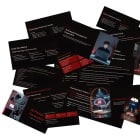The Ultimate AI-Powered Productivity Stack for Entrepreneurs
Stop Wasting Money on Tools You Don't Need
Here’s how to build a lean, integrated productivity system optimized for your specific business using AI-enhanced decision frameworks.
A brandable Workshop Kit is available for this article. Not yet a Coach-level Subscriber? Find out about the Workshops…
Yonking.
Hey there, 👋
Most entrepreneurs are drowning in productivity tools. You’ve got 47 browser tabs open, 12 subscriptions you barely use, and you’re still missing deadlines. Meanwhile, AI-native founders are running lean operations with half the tools at a quarter of the cost.
The difference isn’t which tools they use, it’s how they think about building their productivity system.
This guide shows you exactly how to design your optimal productivity stack using systematic decision frameworks enhanced by AI. From identifying what you actually need instead of what productivity influencers sell, to building integrated systems that work together instead of creating more chaos.
These aren’t tool reviews, these are structured frameworks you can implement today.
The Real Productivity Stack Problem
You didn’t start your business to become a tools administrator. But somehow you’re paying for Notion, Asana, ClickUp, Monday, Slack, Discord, Teams, Zoom, Loom, Calendly, Zapier, Make, and six AI tools you signed up for during free trials.
The average entrepreneur spends $300 to $500 per month on productivity tools. The average entrepreneur also can’t tell you which tools actually move their business forward versus which tools just make them feel organized.
Traditional productivity advice assumes that more tools equal more productivity.
Traditional AI advice assumes you should use AI for everything.
You need neither extreme.
You need frameworks that help you identify what productivity problems you actually have, not what problems productivity tools claim to solve.
You need to understand the opportunity cost of every tool, what you’re giving up by using it instead of alternatives.
You need to design systems where tools work together instead of creating more context switching.
Most importantly, you need to stop buying tools because they’re trending on Twitter and start building a stack optimized for your specific workflow and business stage.
Framework 1: First Principles Productivity Audit
The biggest mistake entrepreneurs make is buying tools before understanding their actual productivity problems. You see a founder rave about Notion, so you migrate everything to Notion, then wonder why your productivity didn’t improve.
AI can help you strip away the noise and identify what productivity problems you genuinely need to solve versus what problems you think you should solve because everyone else is solving them.
Use this prompt to audit your real productivity needs:
I’m an entrepreneur who needs to build an optimal productivity stack. Help me identify my actual productivity problems using first principles thinking.
Current Business Context:
- Business type: [e.g., SaaS founder, consultant, agency owner, creator]
- Team size: [solo, 2-5 people, 5-10 people]
- Annual revenue: [range]
- Primary work activities: [List 3-5 main things you do daily]
Current Productivity Pain Points:
- [e.g., Missing deadlines on client work]
- [e.g., Forgetting to follow up with leads]
- [e.g., Spending 2 hours daily finding information]
- [List 3-5 specific pain points with concrete examples]
Current Tool Stack:
- [List tools you currently pay for and why you bought each]
Please help me:
1. FUNDAMENTAL PROBLEMS: Strip away the symptoms. What are the core productivity problems I actually have? Separate real problems from imagined problems.
2. PROBLEM ROOT CAUSES: For each real problem, what’s causing it?
- Process issue (no system exists)
- Tool issue (wrong tool or no tool)
- Behavior issue (not using existing tools correctly)
- Capacity issue (too much work, not enough time)
3. PROBLEM PRIORITIZATION: Rank my problems by:
- Impact on revenue/business goals
- Frequency of occurrence
- Time cost when the problem happens
4. TOOLS VS. SYSTEMS: For each priority problem, do I need:
- A new tool
- A better process with existing tools
- Changed behavior/habits
- To say no to certain work
5. ANTI-SOLUTIONS: What productivity “solutions” should I specifically avoid because they won’t solve my actual problems?
Focus on what I genuinely need to solve, not what productivity content tells me I should optimize.Example application: Let’s say you’re a solo consultant making $150K annually. Your pain points are missing client deadlines, forgetting follow-ups, spending hours searching for files, and feeling overwhelmed by messages across email, Slack, and LinkedIn.
The critical insight from this audit might be that your fundamental problem isn’t organization, it’s saying yes to too many clients without adequate time buffers. No tool fixes that. Your second problem is context switching between too many communication channels, which a unified inbox or communication boundaries would solve better than another productivity app.
A realistic output might show you that you don’t have a project management problem requiring Asana, you have a client expectation management problem requiring clearer boundaries.
You don’t need a new note-taking app, you need to consolidate the three note-taking apps you’re already paying for.
You don’t need more AI tools, you need to actually use the AI tools you already have.
The audit should make you uncomfortable because it reveals that 40% of your current subscriptions don’t solve actual problems. That’s the point. Cancel those tools and invest that money in solutions for your real problems.
Framework 2: Tool Stack Opportunity Cost Analysis
Every tool you add to your stack has hidden costs beyond the subscription price. Time to learn it. Mental overhead to remember to use it. Context switching between tools. Integration complexity. These costs compound, and they’re often higher than the subscription fee.
The productivity stack question isn’t “is this tool good?” but “is this tool better than my alternatives, and is it worth the total cost of adding it to my system?”

